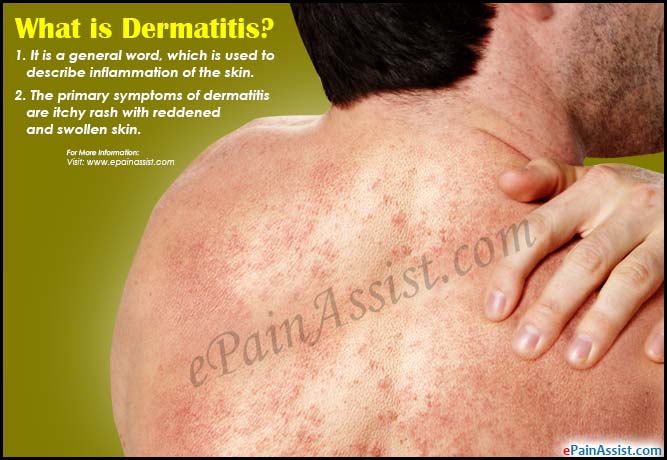What is Dermatitis?
Dermatitis is a general word, which is used to describe inflammation of the skin. There are many types of dermatitis, which have many causes. The primary symptoms of dermatitis are itchy rash with reddened and swollen skin. Other than this, patient suffering from dermatitis may also have blistering and oozing of the skin, which can also develop a crust or there can be flaking of the skin. Some of the types of dermatitis include eczema (atopic dermatitis), dandruff and contact dermatitis, which produce rashes upon contact with any allergen or substances, such as soaps, poison ivy and jewelry. Dermatitis is not a contagious condition and is quite common. It causes discomfort to the patient and makes her/him self-conscious. Treatment of dermatitis consists of medications and different self-care methods.

Causes of Dermatitis
There are different medical conditions, genetic factors, allergies and irritants, which cause different types of dermatitis and some of the causes, are:
Causes of Atopic Dermatitis (Eczema): This type of dermatitis tends to occur from a combination of different factors, such as dry skin, immune system dysfunction, gene variation, environmental conditions and bacterial infection.
Causes of Contact Dermatitis: This type of dermatitis is caused from direct contact with any allergen or irritants, such as nickel containing jewelry, poison ivy, cleaning products, cosmetics, perfumes and certain preservatives present in lotions and creams.
Causes of Seborrheic Dermatitis: This type of dermatitis is caused by fungus (yeast), which is present in the oil (sebum) secreted on the skin. Patients suffering from seborrheic dermatitis suffer from bouts of this condition.
Risk Factors for Dermatitis
- Individuals of any age can suffer from dermatitis; however, atopic dermatitis (eczema) often starts in infancy.
- Individuals working in certain occupations, which put them in contact with certain solvents, metals or cleaning supplies, are at an increased risk for contact dermatitis.
- Individuals having a family or personal history of allergies, eczema, asthma or hay fever are more likely to develop dermatitis.
- Certain medical conditions, such as congestive heart failure, Parkinson’s disease and HIV increases the risk of seborrheic dermatitis.
Symptoms & Types of Dermatitis
Symptoms of each type of dermatitis are different and they occur on different parts of the body. Some of the common types of dermatitis with their symptoms are:
Symptoms of Contact Dermatitis: Patient develops rash on those areas of the body, which has come into contact with certain substances or irritants, such as soaps, jewelry, poison ivy and essential oils. The rash is red in color and causes burning, itching or stinging. Patient can also develop blisters.
Symptoms of Atopic Dermatitis (Eczema): This type of dermatitis often begins in the patient’s infancy. It is characterized by red and itchy rash, which usually occurs where the skin flexes, such as front of the neck, inside the elbows and behind the knees. If the rash is scratched, then it oozes fluid, which crusts over. Patients suffering from atopic dermatitis tend to experience episodes of improvement and flare-ups.
Symptoms of Seborrheic Dermatitis: This type of dermatitis is characterized by red, scaly patches on the skin with persistent dandruff. Seborrheic dermatitis commonly affects the oily regions of the body, such as upper chest, face and the back. Seborrheic dermatitis can be a chronic condition where the patient has periods of remission and flare-ups. This disorder in infants is referred to as cradle cap.
Severe Symptoms of Dermatitis
- Patient is very uncomfortable and is not able to sleep or perform his/her daily chores.
- The skin becomes extremely painful.
- Self-care treatment methods do not yield any results.
- If there is infection of the skin.
Complications from Dermatitis
Scratching of the rash of dermatitis results in open sores, which in turn can become infected. There can be spreading of these skin infections and it can even become life-threatening; however, this is very rare.
Diagnosis of Dermatitis
Physical exam and medical history of the patient are taken where the doctor asks the patient various questions about the signs and symptoms and also examines the patient’s skin. Skin biopsy may be done if needed and other tests are done to exclude other type of conditions.
Patch Testing: If contact dermatitis is suspected, then patch testing on the patient’s skin can be conducted where small amounts of different substances are applied to the patient’s skin beneath an adhesive covering. During the subsequent visits, the doctor checks the skin to see if there has been any reaction to any of the substance. This test helps in determining if the patient has any specific contact allergies. Patch testing is best done after two weeks of clearing up of dermatitis.
Treatment of Dermatitis
Dermatitis treatment differs, depending on the type of dermatitis and its cause. Some of the common treatments done in dermatitis include:
- Application of topical corticosteroids.
- Application of calcineurin inhibitors in the form of lotions or creams. These are the medicines which affect the immune system.
- Phototherapy can be done where the affected area is exposed to controlled amounts of artificial or natural light.
Home Remedies for Dermatitis
- Dietary supplements, which include probiotics and vitamin D, can be beneficial in patients suffering from atopic dermatitis.
- Rice bran broth can be applied to the skin in atopic dermatitis.
- Fish oil supplements can be used in seborrheic dermatitis.
- Tea tree oil can be added to the shampoo or can be used alone as a home remedy for seborrheic dermatitis.
- Aloe vera is also beneficial home remedy in treating dermatitis.
